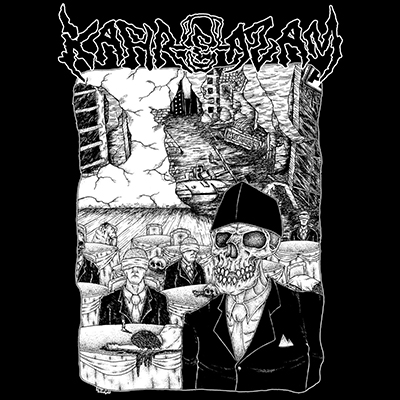If you ever doubted the global pulse of grindcore, listen to KAFIR-E-AZAM. Born in the heat and humidity of Pakistan’s underground, scattered by the tides of migration, and now roaring back to life in Germany, this band’s story isn’t just about music. It’s about borders, identity, and the relentless need to make noise in a world that tries to silence you.

Ashes to Noise: The Pakistani Punk Genesis
KAFIR-E-AZAM’s story begins in the tangled web of Pakistan’s metal and punk scene—a network as fragile as it was fierce. Back in 2013, they made their mark on Tam89’s “Pakistani Punk” compilation, a record that was more than a footnote: it was a shout into the void from a country where punk gigs are rare and rebellion is risky (Unite Asia). The Tam89 connection matters. The French label has made a point of spotlighting scenes from places the rest of the punk world ignores. KAFIR-E-AZAM was Pakistan’s answer to Repulsion and Agathocles, not just in sound but in spirit.
The band’s next move was a split with Rawalpindi’s powerviolence act BVLGHVM in 2014—a pairing that made perfect sense: two bands, both pushing against the limits of what’s possible in a place where venues close and scenes scatter (Unite Asia).
Migration and Diaspora: The Grindcore Exodus
But punk doesn’t stand still. By 2014, KAFIR-E-AZAM fell silent, as migration scattered members across continents. This wasn’t a quiet retreat—it was the same story played out in every underground scene: jobs, visas, borders. The grindcore didn’t die; it just waited.
Fast-forward to 2024. Germany, home to a new wave of migrant punks, becomes the new base. Vocalist Dozakhi and multi-instrumentalist Shehwat Parast have reformed KAFIR-E-AZAM with a vengeance, channeling their anger at displacement, bureaucracy, and the myth of belonging into a sound that’s even rawer than before (Unite Asia).
The EP: Back to the Roots, Forward to the Frontlines
Their self-titled debut EP, recorded in Germany and mixed/mastered by Cimot at Bödi9, is a time machine. Forget modern, clinical grindcore production—these tracks spit in the face of polish. The band’s stated influences are clear: Repulsion, Agathocles, Blood, Fear of God. The drums are frantic, guitars grind and scrape, the bass rumbles like a distant earthquake. Dozakhi’s vocals—pure, desperate, and bilingual—cut through the noise with lyrics that speak to the chaos of life in both Pakistan and Germany.
It’s not nostalgia; it’s a statement. KAFIR-E-AZAM isn’t interested in following trends. Their grindcore is the sound of diaspora, of borders crossed and identities fractured.
Lyrical Themes: Between Two Worlds
Where most bands pick sides, KAFIR-E-AZAM lives in the in-between. Their lyrics tear into the hypocrisies of both their homeland and their adopted home. From the violence of the Pakistani state to the soft racism of Western “tolerance,” the band paints a picture of exile that’s as personal as it is political.
And they’re not alone. KEA sits alongside a wave of “diaspora punk” bands making noise in Europe’s cities—acts that refuse to let migration mean silence (UntoldMag). Their scene is as much about WhatsApp group chats as it is about squats and basement shows.
The KEA Network: Side Projects, Zines, and Legacy
KAFIR-E-AZAM’s members aren’t new to this. Shehwat and Dozakhi have played in MALAMATI, ZANJEER, MYOSIS, and the acerbic MULTINATIONAL CORPORATIONS—a band that’s legendary in Pakistan’s grindcore history (Last.fm). Back in 2012-2014, they also ran The Iron Markhor, a magazine that documented the highs and lows of Pakistan’s tiny, embattled scene.
All of this matters. KEA’s return isn’t just a reunion; it’s a continuation of a project that’s always been about more than music. It’s about building a bridge across continents, about refusing to let punk die just because you have to move.
Art, Identity, and the Future of Grindcore
The new EP features artwork by Distruck Grindcore and a logo by Navneet Yadav—visuals that match the music’s intensity. But what’s most striking is the sense of urgency. KAFIR-E-AZAM sounds like a band that knows the world doesn’t owe it a stage. Every blast beat, every scream, is an act of defiance.
In a world obsessed with neat categories—East and West, first wave and revival, “real” and “fake”—KAFIR-E-AZAM is a reminder that music, like migration, doesn’t care about borders.
Connect and Listen
KAFIR-E-AZAM are carving out a new space for grindcore. If you want to hear what the future of punk diaspora sounds like, start here. You can find their music and updates on their Instagra
Kafir-e-Azam by Kafir-e-Azam



